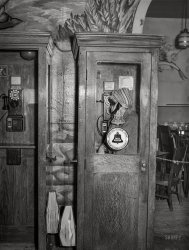
MAY CONTAIN NUTS

Search Shorpy
SHORPY ART

Framed or unframed, desk size to sofa size, printed by us in Arizona and Alabama since 2007. Explore now.
Join and Share
Ad-Free Shorpy
Shorpy is funded by you. Patreon contributors get an ad-free experience.
Learn more.

Recent comments
- A Beautiful Moment
- Such joy
- Bethune-Cookman University today...
- Yellow sky at morning
- Side Winder
- Air Quality?
- Sojourner Truth riot
- None were so blind(ed)
- The less famous sister
- Good ol' days?
- Rise and Fall
- Goo Goo Ga Joob
- Ticket Retention
- Not the only one
- Vagaries of War
- Killed by Amtrak
- Back to the Future
- Wanted --
- If you can't stand the light
- Centralized Traffic Control, I believe
- What's really happening
- Heckuva remote control!
- Sometimes — Things Go Bump!
- I SEE THE LIGHT
- Union Switch and Signal Company
- Get That Light Out Of My Eyes
- Eggs. Eggs. Eggs. The Egg Man is Here!
- Foreboding caption
- Famous Hollywood faces
- Not just S&P
Member Photos
The Shorpy
Print Emporium
Print Emporium
Search Shorpy
Search results -- 30 results per page
- Tin Can Alley: 1941
- ... 'black belt,' Negro section on the South Side." Photo by Russell Lee. View full size.
The Projects The goal of public housing in ... Posted by Dave - 12/11/2018 - 2:18pm -
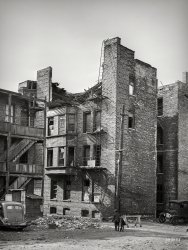
- Action Comics: 1940
- ... a dime. Decisions, decisions! Medium format negative by Russell Lee. View full size.
N°2 Wagon From the 1925 Cretors catalogue: ... Posted by Dave - 06/18/2018 - 1:20am -
![Action Comics: 1940 April 1940. "Popcorn stand in Globe [i.e., Miami], Arizona." Where we can pick up a slightly dog-eared copy of Famous Funnies or Action Comics #23 for a dime. Decisions, decisions! Medium format negative by Russell Lee. View full size.
N°2 WagonFrom the 1925 Cretors catalogue:
A GREAT favorite, and the cheapest wagon machine we build. Thoroughly dependable in operation; very simple and durable. Hundreds of these machines are being used in connection with stores, sidewalk stands and other lines of business, with gratifying results.
A No. 2 Wagon operated in front of your store is worth its cost as an advertisement alone. We are pleased to continue a model which in the past has proven itself the most successful and best money getter of any machine on the market of equal price.
Store owners cannot afford to ignore this attractive and profitable adjunct to their business.
Peanut Roaster capacity, about 10 pounds.
Dimensions — Frame, 20 inches wide by 52 inches long. Popper case, 20x20x24 inches high. Extreme width, 31 inches. Height, 5 feet 10 inches. Weight, about 300 pounds.
Write for Special Bulletin and complete Specifications.
Price and Installment Terms on Request.
Get your popcorn readyC. Cretors & Co. has been around for a good long time.
Charles Cretors introduced the world's first mobile popcorn machine at the World's Columbian Exposition in Chicago in 1893. Scientific American reported: "This machine ... was designed with the idea of moving it about to any location where the operator would be likely to do a good business. The apparatus, which is light and strong, and weighing but 400 or 500 pounds, can be drawn readily by a boy or by a small pony to any picnic ground, fair, political rally, etc. and to many other places where a good business could be done for a day or two."
https://www.popcorn.org/Facts-Fun/History-of-Popcorn/History-of-Popcorn-...
Fior D'Italia boarding houseOne recurring facet of life in mining towns like Globe was the presence of boarding houses with sarcastically classy names. Beyond the popcorn machine may be seen the Fior D'Italia boarding house. That was also the name of a business establishment in San Francisco that now claims to be the oldest restaurant in the city. Little sign can be found of the fate of this humble abode, which is not among the places mentioned in the Globe Downtown Historic District registry.
[Pretentious, maybe, but sarcastic? According to the sign, the proprietor is one Angelina Bairo (1880-1955), born in Turin, which would explain the name, which means "Flower of Italy." - Dave]
Action Comics 23This issue was the first appearance of Lex Luthor.
This very issue is on eBay for $6,500.
Got a dime?That dime would have bought you a comic now worth somewhere between $1000 (min) and $65,000 (record). #23 was the first appearance of Lex Luthor.
Busty lady of shady laneForget the comic books. The boys might be more distracted by the sexy lady on the cover of "True Confessions," which was kinda brazen for 1940.
Even after using PhotoshopI can't make out what that sign in the window says. Help, anyone?
[Magazines 5¢ - Dave]
Thanks!
$14,694Check out this copy of Action #23 -- winning bid $14,694.
It's a mini-steam plant!It's got it all!
1) Cute mini single-cylinder steam engine with a round belt going off to the lower right. (Belt visible behind the "4 o'clock" position of the flywheel.)
2) Feedwater tank on the left side.
3) Boiler water level glass on the right end.
4) Firebox drawer front and center, right below the smokestack which goes up the left side of the glass popcorn chamber
5) Last but not least, a steam pressure gauge which seems to be calibrated 0-60 PSI. One could presume a working pressure in the middle of that range.
In today's world, one would need a boiler operator's license to run a boiler with a working pressure of 30 PSI. The boiler would have to have an inspection certificate.
Certainly an interesting machine!
Re: True ConfessionsMy eyes are up here, Mister!
413 Sullivan Street.I believe, based on the windows and openings in the building, and the hill in the background, that we are here:
(The Gallery, Russell Lee, Stores & Markets)](https://www.shorpy.com/files/images/SHORPY-8b24474a.thumbnail.jpg)
- Twin Falls: 1941
- ... it is a shipping center for potatoes and onions." Photo by Russell Lee for the Farm Security Administration. View full size.
License plate ... Posted by Dave - 09/22/2018 - 7:28pm -
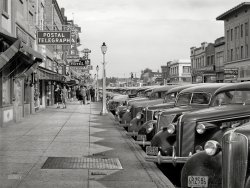
- Mogollon, N.M.: 1940
- ... street of Mogollon, New Mexico." Medium format negative by Russell Lee for the Farm Security Administration. View full size.
Coronado ... Posted by Dave - 08/08/2018 - 5:16am -
![Mogollon, N.M.: 1940 May 1940. "On the main street of Mogollon, New Mexico." Medium format negative by Russell Lee for the Farm Security Administration. View full size.
Coronado Cuarto Centennialis the slogan across the top of the 1940 NM license plate facing us, celebrating the 400th anniversary of an expedition into modern New Mexico by the Spanish explorer of that name. The slogan was intended to promote the many cultural and historical commemorative events held in that year. The tag, vivid yellow on red, features the Zuni sun symbol (the Zia) used on NM plates from 1927 to the present day. Combining all these attributes makes this license plate one of the most collectible of all.
So ...According to Wikipedia, Mogollon "was founded in the 1880s at the bottom of Silver Creek Canyon to support the gold and silver mines in the surrounding mountains. A mine called Little Fannie became the most important source of employment for the town's populus. During the 1890s Mogollon had a transient population of between 3,000 and 6,000 miners and, because of its isolation, had a reputation as one of the wildest mining towns in the West."
["Populus" ?? - Dave]
Watch your stepThere seems to be a rather deep hole at the end of the sidewalk. The two gents outside the cafe might at least put up a sign.
This ain't Mount AiryUntil this moment, I thought that "Snappy Lunch" was exclusively a Mayberry thing!
Mogie-yawnNever heard "Mogollon" pronounced by a native Spanish speaker, but the locals near the Mogollon Rim county in AZ and NM call it "mogie-yawn." Named for the Spanish Governor of New Mexico in the early 18th century, the escarpment is cut with canyons and crested with the largest ponderosa pine forest on this planet.
A beautiful place and a favored recreation locale of mine, especially the area that straddles the AZ/NM state line. Little native Apache trout live in the streams, black bear and gray wolves in the forested areas and huge elk graze the open parks. Sublime.
[See you at Big Lake. - Dave]
Welcome to the Anachronical Cafe!Visually, this is on the border of the 19th Century Wild West and modern 20th Century. Texaco and Coca Cola signs above antique boardwalks, modern traffic on millennially old dust road, an automobile in a "garage" that looks like a shelter used centuries ago by nomads etc. In the middle of this anachronistic image, two men and cat, witnessing the passing of time.
P.S. I saw the top left corner of the image and for a moment I said to myself: "look, they have a SHORPY sign on that slope of the mountain". Yes, it was not a landmark, but a watermark.
More Recent Mogollon Two buildings on the left are still present, at least in 2008, but the Shorpy sign is gone. Someone's still sitting out on the road, this time guarding the Mogollon Museum!
(The Gallery, Cars, Trucks, Buses, Cats, Russell Lee, Small Towns)](https://www.shorpy.com/files/images/SHORPY-8b25143a.thumbnail.jpg)
- Less Filling: 1939
- ... San Augustine, Texas." Medium format acetate negative by Russell Lee for the Farm Security Administration. View full size.
12 Cents ... Posted by Dave - 03/20/2018 - 9:04pm -
![Less Filling: 1939 April 1939. "Service station. San Augustine, Texas." Medium format acetate negative by Russell Lee for the Farm Security Administration. View full size.
12 Cents Sounds Good...until you put it in an inflation calculator. It winds up being $2.11--about what we would pay now! At least we don't have to worry about patching our tubes any more, though.
Pump it upThere was a time that motorists or station attendants had to grab hold of a lever and literally pump up the fuel before filling the gas tank. However, despite changes at service stations with modern gasoline dispensers that don't use the old levers they are still referred to today as "gas pumps."
[Because that's still what they do -- pump gas up out of an underground tank. - Dave]
Drink **** ****is there anywhere in the United States where there isn't a Coca-Cola sign?
Gotta Love Hot PatchingMy dad taught me how to do this sort of patching a punctured tire, though it may differ from what's being sold here. To patch the inside or a tire or outside of a tube you first roughed up the rubber with a coarse perforated file, much like a cheese grater. Then you applied a coat of tire patch cement, which contains considerable volatile solvents. Then you lit the solvent and allowed it to burn for about 15-20 seconds... this had the effect of making the cement far more sticky and also slightly melting the top layer of the rubber tube/tire. Then you removed the backing from the patch, applied it to the puncture, and used a roller, or the edge of the can of patches, to press down the patch into the repair. It worked amazingly well and I don't recall ever having to re-do one.
Bicycle Tube Vulcanisers In Australia in the 1950s and 60s we patched our bicycle inner tubes with a Dunlop Vulcaniser. A patch was placed on the hole in the tube, and held in place with a clamp device. A small circular disc with a layer of a catalyst was placed in the clamp, and this was ignited. The heat, with attendant smoke, welded the patch to the tube. In a few minutes it cooled, and you were on your way again. No waiting for glue to dry. You can see a sample here.
Now That's How You Splice WiresGotta love the wiring for the overhead light and pumps. Perhaps a little bit of electrical larceny going on there?
Shorted wiring?At the end of the pump shed is a cross tree with two wires on it. It looks like the wire on the right has been shorted and the insulation is starting to melt off. Not surprising when you see an indoor socket hanging out in the open just to the right of the roof.
Different kind of hot patchingThe brand of hot patch being referred to here is Shaler, which was a self-vulcanizing type of patch similar to the ubiquitous "Monkey Grip sizzle patches" of bygone days. They used a rubber patch attached to the back side of a thin metal clamp-on tray of combustible chemicals to melt/vulcanize the rubber patch to the tube or tire, unlike the modern hot patches that just rely on burning off solvent to heat up and soften a rubber surface to promote adhesion.
Although not sold directly in the US any more, real self-vulcanizing patches are still made in and available from China and India.
(The Gallery, Gas Stations, Russell Lee, Small Towns)](https://www.shorpy.com/files/images/SHORPY-8b21592a.thumbnail.jpg)
- Lone Star Slugger: 1939
- ... game in San Augustine, Texas." Medium format negative by Russell Lee for the Farm Security Administration. View full size.
(The Gallery, ... Posted by Dave - 03/22/2018 - 11:43am -
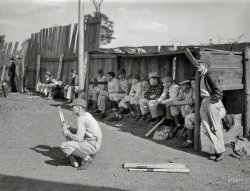
- Twin Towers: 1940
- ... of the Shasta Dam is distributed." Acetate negative by Russell Lee for the Farm Security Administration. View full size.
(The Gallery, ... Posted by Dave - 01/24/2019 - 5:31pm -
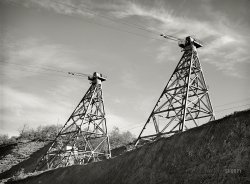
- School Zone: 1941
- ... section of Chicago, Illinois." Medium format negative by Russell Lee for the Farm Security Administration. View full size.
(The Gallery, ... Posted by Dave - 09/21/2018 - 7:30pm -
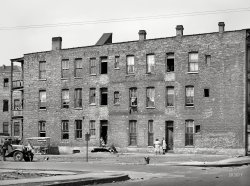
- Counting Steers: 1940
- ... on our buckaroo's suitcase reads "R.R. Walston." Photo by Russell Lee for the Farm Security Administration. View full size.
A Whiff of ... Posted by Dave - 06/28/2018 - 10:26am -
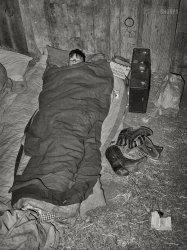
- Sons of Pomp: 1940
- ... hogs. Creek County, Oklahoma." Medium format negative by Russell Lee for the Farm Security Administration. View full size.
(The Gallery, ... Posted by Dave - 07/19/2018 - 6:00pm -
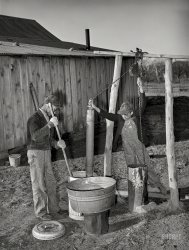
- Gray Onions: 1941
- ... Did Shorpy just hear a Who? Medium format negative by Russell Lee for the Farm Security Administration. View full size.
(The Gallery, ... Posted by Dave - 06/01/2019 - 1:49pm -

- Uray for Hollywood: 1940
- ... Path" with Ginger Rogers and Joel McCrea. Photo by Russell Lee. View full size.
Gone today These ornate facades were made by ... Posted by Dave - 11/06/2018 - 8:01pm -
![Uray for Hollywood: 1940 September 1940. "Theater in Ouray, Colorado." Now playing: "Primrose Path" with Ginger Rogers and Joel McCrea. Photo by Russell Lee. View full size.
Gone todayThese ornate facades were made by two competing family companies, the Mesker Brothers Iron Works of St. Louis or George L. Mesker & Co. of Evansville, Indiana. Ouray had 15 such buildings. The Hiebler building is the only Mesker non-survivor.
Through dark of nightIt appears that the theatre is gone and in its place, a small post office. If you look at the mountains behind, they fit the configuration of the one in the above picture of the Uray. BTW, it was named after Chief Uray; I don't know when or why they added the "O".
[His name is generally spelled Ouray, although one is just as arbitrary as the other, devised as it was by users of the Roman alphabet. - Dave]
He/she is baaack!One of the coming attractions advertised is "Too Many Husbands," a Columbia Pictures comedy staring Jean Arthur as a wife whose first husband is supposedly lost in a shipwreck, only to return after she remarries. A couple of months later, RKO released "My Favorite Wife," a comedy staring Cary Grant as a husband whose first wife is supposedly lost in a shipwreck, only to return after he remarries.
Nearly every one of the silver-rush-era buildings on Main Street in Ouray with cast-iron facades has been preserved. This building, sadly, is the exception.
What a facade!From https://www.boxcanyonouray.com/ouray-heritage/history-of-ouray-the-meske...
For profit-minded businessmen in the late 1800’s the goal was to stand out from the crowd. For those who couldn’t afford fancy masonry or cast iron embellishments, there was an alternative: pick up a catalogue and order a decorative, galvanized sheet metal facade from the Mesker Brothers Iron Works or George L. Mesker & Co. Purchasers could pick and choose from a range of cast iron and pressed metal mass-produced components or spring for a lavish top-to-bottom facade. Their order would come in by train and in just a few days, a plain brick or wood box of a building could be transformed into a beautifully elegant edifice, at roughly one-fifth the cost of a masonry facade.
Moved across the street since 1940?And partially modified on the ground floor entrance? If so, the "Uray Theatre" is still standing.
"Cinema Treasures" (http://cinematreasures.org/theaters/28411) incorrectly lists the former Uray Theatre was located at the site of the historic Wright Opera House (southwest corner of Main and 5th), whose dimensions and facade look nothing like the above.
BUT, using Google Earth at street level, going half a click north of the Main & 5th on the east side of the street just after the Beaumont Hotel is an identical building to the Uray Theatre - same facade and ornamentation (sans triangular structure on the cornice up top and "James" in place of "18HEIBLER89"), only the ground entrance modified. Take a look at the street view - looks like the same building, just moved across the street sometime after 1940:
[The Uray Theatre was at 624 Main Street. The building seen below is next to the Beaumont Hotel at 515 Main -- two entirely different structures. As noted in the other comments, there are over a dozen buildings in Ouray with similar facades. - Dave]
14 out of 15 ain't badExcept for this building. The article linked by FixIt says that of the 15 Mesker façades installed in Ouray, 14 still remain. The exception: the Hiebler building at 624 Main St.
Murder and Suicide Startles CityNews clipping about the Hiebler family in Ouray. Click for the rest of the story.
(The Gallery, Movies, Russell Lee, Small Towns)](https://www.shorpy.com/files/images/SHORPY-8b26234a1.thumbnail.jpg)
- Sinclair Serviceman: 1939
- ... operator in Seminole, Oklahoma." 35mm nitrate negative by Russell Lee for the Farm Security Administration. View full size.
(The Gallery, ... Posted by Dave - 06/09/2018 - 10:25am -
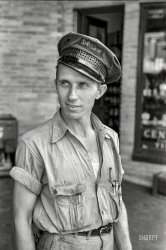
- Farmhouse Kitchen: 1940
- ... bacon, milk and coffee. Creek County, Oklahoma." Photo by Russell Lee for the Farm Security Administration. View full size.
Census ... Posted by Dave - 07/19/2018 - 9:35pm -
![Farmhouse Kitchen: 1940 February 1940. "Family of tenant farmer Pomp Hall, eating breakfast consisting of corn flakes, biscuits, fried bacon, milk and coffee. Creek County, Oklahoma." Photo by Russell Lee for the Farm Security Administration. View full size.
CensusRealizing Pomp is probably not his given name. I did many searches but came up empty. Odd.
MilkAt first I thought using plates for the corn flakes odd. But it keeps you from using too much milk. My grandmother (born 1903) hated when us chaps used too much milk in the cereal bowl and just poured it down the sink.
And the use of fresh newspaper on the table surfaces kept them cleaner. A charming family photo, although poor. Mama doesn’t like the intrusion but her family looks well fed.
[That's not Mama, who is seated next to her husband. - Dave]
Could be that he moved by 19401940 United States Federal Census
Name: Pompey Hall
Age: 50
Estimated Birth Year: abt 1890
Race: Negro (Black)
Birthplace: Arkansas
Marital Status: Married
Home in 1940: Spring Creek, Phillips, Arkansas
Farm: Yes
Inferred Residence in 1935: Rural, Phillips, Arkansas
Residence in 1935: Rural, Phillips, Arkansas
Resident on farm in 1935: Yes
Occupation: Farmer
House Owned or Rented: Rented
Attended School or College: No
Highest Grade Completed: Elementary school, 3rd grade
Class of Worker: Working on own account
Household Members:
Name Age
Pompey Hall 50
Missouri Hall 49
Willie R Landford 13
Looks familiarThat newspaper on their dinner table is a copy of the now defunct Tulsa Tribune. I see ads for both Street's Clothing and Renberg's, a clothing store as well. They have been closed for quite a while. My very first IT job was at Renberg's starting in November 1977. The old Renberg's sign is still on the building at 311 S. Main in Tulsa. My grandfather attended Central High School with George Renberg. He said he was jealous because George would come to school in a different suit every day!
(The Gallery, Kitchens etc., Rural America, Russell Lee)](https://www.shorpy.com/files/images/SHORPY-8b23704a.thumbnail.jpg)
- Peel Me a Carrot: 1940
- ... The lady last seen here . Medium format negative by Russell Lee. View full size.
Code? What code? The electrical tape around ... Posted by Dave - 07/26/2018 - 10:55pm -
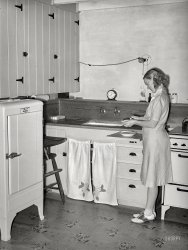
- Play Party: 1940
- ... Joe, but have you seen Billy's new mustang? Photo by Russell Lee for the Farm Security Administration. View full size.
(The Gallery, ... Posted by Dave - 06/20/2018 - 11:47am -
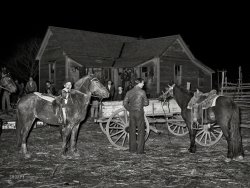
- Rest Stop: 1938
- ... wagon of Lasses White show. Sikeston, Missouri." Photo by Russell Lee. View full size.
(The Gallery, Russell Lee) ... Posted by Dave - 12/13/2018 - 3:26pm -
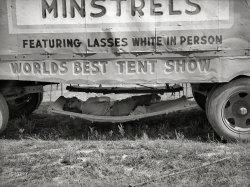
- Animal Husbandry: 1940
- ... the San Angelo Fat Stock Show." Medium format negative by Russell Lee for the Farm Security Administration. View full size.
(The Gallery, ... Posted by Dave - 07/20/2018 - 1:37pm -
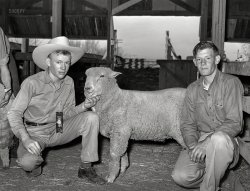
- Twin Falls II: 1941
- ... in towns in the section, of being planned." Photo by Russell Lee for the FSA. View full size.
Corner of Main Avenue East and Hansen ... Posted by Dave - 09/23/2018 - 10:57am -
![Twin Falls II: 1941 From start to finish, a life on wheels.
May 1941. "Main street of Twin Falls, Idaho. According to Idaho State Guide (Federal Writers Project), this town has the distinction, unusual in towns in the section, of being planned." Photo by Russell Lee for the FSA. View full size.
Corner of Main Avenue East and HansenThe air-conditioned Rogerson Hotel on our left was at the north corner of Main Avenue East and Hansen Street East, so this view has us looking southeast.
+75 Much lower and much leafierMain Avenue East has received a good deal of urban forest plantings in the last three-quarters of a century, while the taller buildings have generally lost their upper stories. The Rogerson Hotel building is visible at left; its top story went after a 1935 fire. The entire building was demolished as too far gone to save in 2016, one year after this Google cap.
The Golden Rule in the next block is now a furniture store, and many of the buildings we see have fallen victim to cases of "façade modernization" disease, when they haven't fallen altogether.
[Dear people: Please learn how to embed a google Street View before posting. I'm tired of doing it for you. - Dave]
Dave, the instructions said "links will be converted" and I trusted that. Bad link removed.
How to include Google Street View in a commentDave, it must be frustrating to keep telling people how to include Street View URL links in comments. You did so for me some time ago and I thank you. But the latest time I included such a URL it was just random luck the URL worked. I'd forgotten the trick and had no way to find it.
Perhaps the working trick of referencing Street View could be put at the top of the Comment Guidelines? Or even added as an item in the comment entry form? "Paste a street view URL link"?
[There is no "trick." Simply apply eyeballs and brain to what's in front of your nose. And of course you could always google it! - Dave]
Easier, but ....This angled parking layout was very popular in the Midwest of my youth, though backing out safely often depended on the restraint of one's fellow motorists as well as one's own lumbar flexibility.
Unfortunately, becoming accustomed to "nose-in" parking while learning to drive often had a deleterious effect on one's ability to parallel park for the driver's license test!
Right over thereHe said he'd leave the package in a gray Plymouth, or was it a Dodge?
And NowThe view is Main Street at Hansen, looking southeast. The remains of the air-conditioned Rogerson Hotel are at the left, the building with the ugly (aluminum?) siding. It was torn down after this Street View was taken in 2012.
(The Gallery, Cars, Trucks, Buses, Russell Lee, Stores & Markets)](https://www.shorpy.com/files/images/SHORPY-8c01109a.thumbnail.jpg)
- Government Mules: 1939
- ... loan. Near Ordway, Colorado." Medium format negative by Russell Lee for the Farm Security Administration. View full size.
(The Gallery, ... Posted by Dave - 08/26/2018 - 4:59pm -
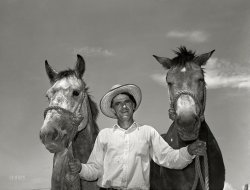
- The Mint: 1940
- ... towns near Shasta Dam." Medium format acetate negative by Russell Lee for the Farm Security Administration. View full size.
Sam Crawford, ... Posted by Dave - 08/31/2018 - 2:07pm -
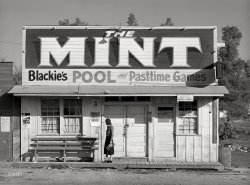
- Chips off the Block: 1940
- ... Corpus Christi, Texas." Medium format acetate negative by Russell Lee. View full size.
Acronyms Does anyone know what the acronyms on ... Posted by Dave - 09/19/2018 - 8:44pm -
![Chips off the Block: 1940 December 1940. "Family of carpenter's helper who live in a trailer. Corpus Christi, Texas." Medium format acetate negative by Russell Lee. View full size.
Acronyms Does anyone know what the acronyms on that fedora’s hat badge stood for? I doubt Washington State University for one.
[W.S.B., not W.S.U. And those are abbreviations, not acronyms. - Dave]
Interesting family photoLooks like Mom has been wearing gloves and Dad should have.
Life in the 40's was dangerous!This is at least the third photo posted this past week where the subject had a finger injury.
One here:
https://www.shorpy.com/node/23815?size=_original#caption
Another here:
https://www.shorpy.com/node/23791?size=_original#caption
Family Portrait ThoughtsDad has a friendly face and would help you do anything and loan you his last dollar.
Mom is a beauty hidden under a bushel of poverty. An afternoon at the beauty parlor would bring out the beauty especially with a Hedy LaMarr hairdo, eyebrow and eye makeup and a glorious smile.
Sister with a cute half smile and pout that shows how much she loves daddy and don't you dare mess with him.
Brother has a mischievous look and mom doesn't dare put him down or else he'll be all over the photographer's equipment.
A fine looking family and I hope things went well for all.
-----------------------
Hedy Lamarr Quote ...
"Any girl can be glamorous. All you have to do is stand still and look stupid."
A word to the wise from one of the smartest movie stars of any era.
I always wonderMy mom's family was in Corpus Christi around that time. She would have been 8 years old. Her dad was looking for work and they traveled from Nashville to Texas in the hopes of finding a job. They lived in a shanty on a hill overlooking a river. She told me that the floors were dirt and you could look out between the boards that made up the walls.
It's no surprise that in her adult life she's adamant that she will never wear dirty or torn clothing, and will not be seen without her makeup. Once, when we were discussing her childhood, she said with tears in her eyes that she will never again let anyone think that she was poor.
I sometimes wonder if her picture is in the Shorpy archives.
(The Gallery, Kids, Russell Lee)](https://www.shorpy.com/files/images/SHORPY-8c00339a.thumbnail.jpg)
- Laundry Legs: 1940
- ... would be of a permanent nature." Acetate negative by Russell Lee for the Farm Security Administration. View full size.
Ice-free ... Posted by Dave - 09/06/2018 - 3:54pm -
![Laundry Legs: 1940 September 1940. "Old house in Silverton, Colorado. This was the type of house built by mine and mill operators in the early mining days and indicates that the owners felt that the mining operations would be of a permanent nature." Acetate negative by Russell Lee for the Farm Security Administration. View full size.
Ice-free eaves, anyone?I like this early answer to the ice-dam problem: start with about 3 feet of a smooth material (probably sheet metal), then shingle the rest of the way to the peak. Snow may pile up on the roof, but ice and snow will slide off that slippery colder area over the eaves. Pretty slick. (pun intended)
Schmatte Hari In case you missed it, here are the Laundry Legs, with well-turned ankles and fashionable shoes to match.
But horrors, what kind of shenanigans might be going on here?
Has a nude clothes hangerupperist invaded our family-friendly web refuge?
Has Shorpy been hacked by a Russian spy?
Will she show up in the Pretty Girls Gallery?
All hail the QueenLovely example of the Queen Anne style. Love the dotted-Swiss curtains in the parlor. Bet that upstairs bedroom is hot in the summer as evidenced by the expanding screen in the window.
Looks like one or more fireplaces have been closed up in the present-day picture as evidenced by the missing chimneys. Note that the front porch has also been enclosed into the body of the house.
Even older nowAmazingly, still there. Heavily modified but same old bones and main features still recognizable. The 1940 photo would make a wonderful reference if the owner ever wanted to bring it back.
Spatially-challenged dept.I’m wondering if anyone else had a problem with that horizontal board running the width of the house, separating upper from lower floor. For the life of me, I couldn’t figure out how, at the front of the house, it was in the same plane on the left as on the right, where the porch appears to jut out. So I consulted a carpenter friend, who patiently and charitably pointed out to me that the outer edge of the porch is in fact on the very same plane as the two windows on the left, due to the fact that the doorway is inset. Just to the left of the single window in the center, the façade dives in on a diagonal, creating the setback of the porch. Sometimes I really don’t know what I’m looking at, and it helps to have friends who are not similarly afflicted.
[That's a bay window with four lights. - Dave]
(The Gallery, Dogs, Mining, Russell Lee, Small Towns)](https://www.shorpy.com/files/images/SHORPY-8b26272a.thumbnail.jpg)
- Garage à Trois: 1940
- ... Durango, Colorado." Medium format acetate negative by Russell Lee for the Farm Security Administration. View full size.
Now ... simulation:
(The Gallery, Railroads, Russell Lee) ... Posted by Dave - 04/27/2020 - 9:58am -
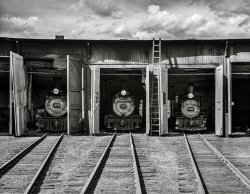
- The Locomotion: 1940
- ... the yard at Big Spring, Texas." Medium format negative by Russell Lee for the FSA. View full size.
Lima Locomotive This is a Texas ... Posted by Dave - 06/18/2018 - 1:32pm -
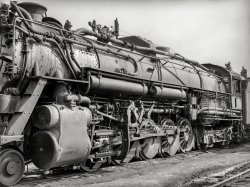
- Railway Express: 1940
- ... service is not otherwise available." Acetate negative by Russell Lee for the Farm Security Administration. View full size.
Crate address ... Posted by Dave - 09/30/2018 - 7:56pm -
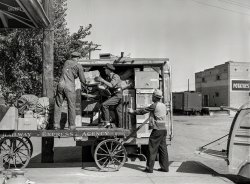
- Montrose Newsies: 1940
- ... Montrose, Colorado." Medium format acetate negative by Russell Lee for the Farm Security Administration. View full size.
Essential ... Posted by Dave - 09/13/2018 - 12:55pm -
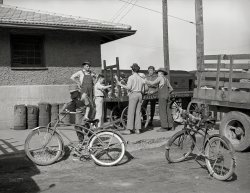
- Bank of Bisbee: 1940
- ... center of Bisbee, Arizona." Medium format negative by Russell Lee for the Farm Security Administration. View full size.
The ... Posted by Dave - 09/10/2018 - 8:19pm -
![Bank of Bisbee: 1940 The Bank of Bisbee had a starring role in "Violent Saturday," a 1955 film noir shot on location with Bisbee recast as "Bradenville," and Ernest Borgnine somewhat improbably playing an Amish farmer whose family is held hostage by bank robbers.
May 1940. "Bank in copper mining center of Bisbee, Arizona." Medium format negative by Russell Lee for the Farm Security Administration. View full size.
The Name's ChangedThe rest remains the same. In fact, of all the towns featured on Shorpy, Bisbee seems to be the one that has changed the least.
[Indeed. Although last time I was in Bisbee, it was a Bank of America. - Dave]
Violent BisbeeStill frame from "Violent Saturday." Note the start of "Bisbee" on the old Coca-Cola sign on the side of the building above the Studebaker. Click to enlarge.
Faux Stone PaintersThere was great scenery shop work on the Bank of Bradenville sign. I had to go back to notice how they covered up the Bank of Bisbee lettering. It was probably just plywood painted to look like stone. I understand that for much of the fist half of the Twentieth Century, people who could do that were in great demand. The classic example was all the temporary buildings at world's fair sites.
Bisbee: Another Violent Starring RoleBisbee was the site of real-life violence in 1917. It is the subject of a newly released movie, "Bisbee '17".
"Radically combining collaborative documentary, western and musical elements, the film follows several members of the close knit community as they attempt to reckon with their town's darkest hour. In 1917, nearly two-thousand immigrant miners, on strike for better wages and safer working conditions, were violently rounded up by their armed neighbors, herded onto cattle cars, shipped to the middle of the New Mexican desert and left there to die. This long-buried and largely forgotten event came to be known as the Bisbee Deportation." Quoted from Rotten Tomatoes, where the movie gets a 94% approval rating.
(The Gallery, Russell Lee, Small Towns)](https://www.shorpy.com/files/images/SHORPY-8b24980a.thumbnail.jpg)
- Re-Tirement Home: 1940
- ... first Krispy Kreme franchise. Medium format negative by Russell Lee for the Farm Security Administration. View full size.
Carbonated ... Posted by Dave - 06/19/2018 - 10:17pm -
![Re-Tirement Home: 1940 March 1940. "Secondhand tires displayed for sale at service station in San Marcos, Texas." A leading candidate for the first Krispy Kreme franchise. Medium format negative by Russell Lee for the Farm Security Administration. View full size.
Carbonated CokeIt seems that this 1937 Ford sedan's flathead V8 is getting a de-coke job. The engine compartment's side panel has been removed for access and is resting against the Ford tire rims along the wall, with a new head gasket lying on it. The cylinder head has been removed and the gent who is just visible behind the right side of the car is scraping the carbon that has built up inside the head's combustion chambers (called decoking or decarbonizing). This was a common procedure on older cars, given their low compression and the poor quality of fuels. Buildup of carbon (coke) led to a drop in engine performance, so it had to be cleared out from time to time. Indeed many owner's manuals even had the procedure detailed for the owner to perform himself.
Why I follow ShorpyThe wonderful titles, hilarious takes like the "first Krispy Kreme franchise" in descriptions, and that the very first comment is a detailed explanation of what some guys working on a car 80 years ago were really doing.
Major repairsAt the time it was common practice to do engine overhauls, including the aforementioned carbon removal, cleaning out the oil pan and passage, and replacing the main bearings. In many cases, the main bearings were poured in place - the bearing material (babbit or something like it) would be melted and poured into place in the journals. This was something a good service station would do, maybe in less than as 50,000 miles.
This was before detergent oil, so crud would just fill it up eventually. I have seen cars from as late as the 60s where oily sludge had built up to the point that it filled up the engine, so you could take off a valve cover, and have a 6" deep layer of sludge in the shape of the interior of the valve covers, with small gaps where the oil was forced out of the passages.
Now it is normal and expected that an engine will run 200,000 miles with no internal failures or significant wear, and no real maintenance aside from oil changes. To the point that everything else in the car has been destroyed long before the engine goes bad. The "good old days" sucked, for the most part.
Wheeling in more ways than oneThe building is at least partially clad in Wheeling Corrugating Company's "Cop-R-Loy" steel, as we can see by the imprint above the side garage. This brand of sheet goods consisted of a mild steel with a small amount of copper added to reduce corrosion. It was quite popular and used in a great many water-contact steel products of that era. I still have a bucket in the garage with the same brand ... and still no rust!
It's 1939 and 1940The month is March, and the Model A coupe is wearing a 1940 license plate, while the '37 Ford sports a 1939 plate. Until 1975, vehicles in Texas had to get new plates every year, and drivers had from January through March to register. This usually meant long lines of procrastinators at county tax offices at the end of March each year.
Third row, second from leftand put it on my new-fangled Sinclair credit card.
Just off the squareWithout going to stand on the spot I can't be 100 percent positive, but I believe this station stood on West Fort Street, also known as Texas Highway 80, maybe half a block west of the courthouse. (Fort Street was later renamed Hopkins.) At the far left of the picture, one of the cornices of the Hays County Courthouse (still standing, now with a New Improved Historic Designation) is visible.
Sinclair Credit CardsI didn't know there were credit cards of any kind back in those days.
Sinclair Gas Credit CardThe card was not a credit card but a GAS CARD, that you pre-filled before a trip that you could use to pump gas at their stations. The research on Sinclair's Website only turned up data about the company here.
[Like the sign says, it's a credit card. You charged your gas, then the company mailed you a statement at the end of the month. Pre-filled cards had to wait for the computer era. - Dave]
[Ah! I stand corrected]
(The Gallery, Cars, Trucks, Buses, Gas Stations, Russell Lee)](https://www.shorpy.com/files/images/SHORPY-8b24221a.thumbnail.jpg)
- Buy a Slug: 1941
- ... hole known as Tony's Tavern. Acetate negative by Russell Lee. View full size.
Those happy carefree days ... ... when your ... Posted by Dave - 09/30/2019 - 1:54pm -
